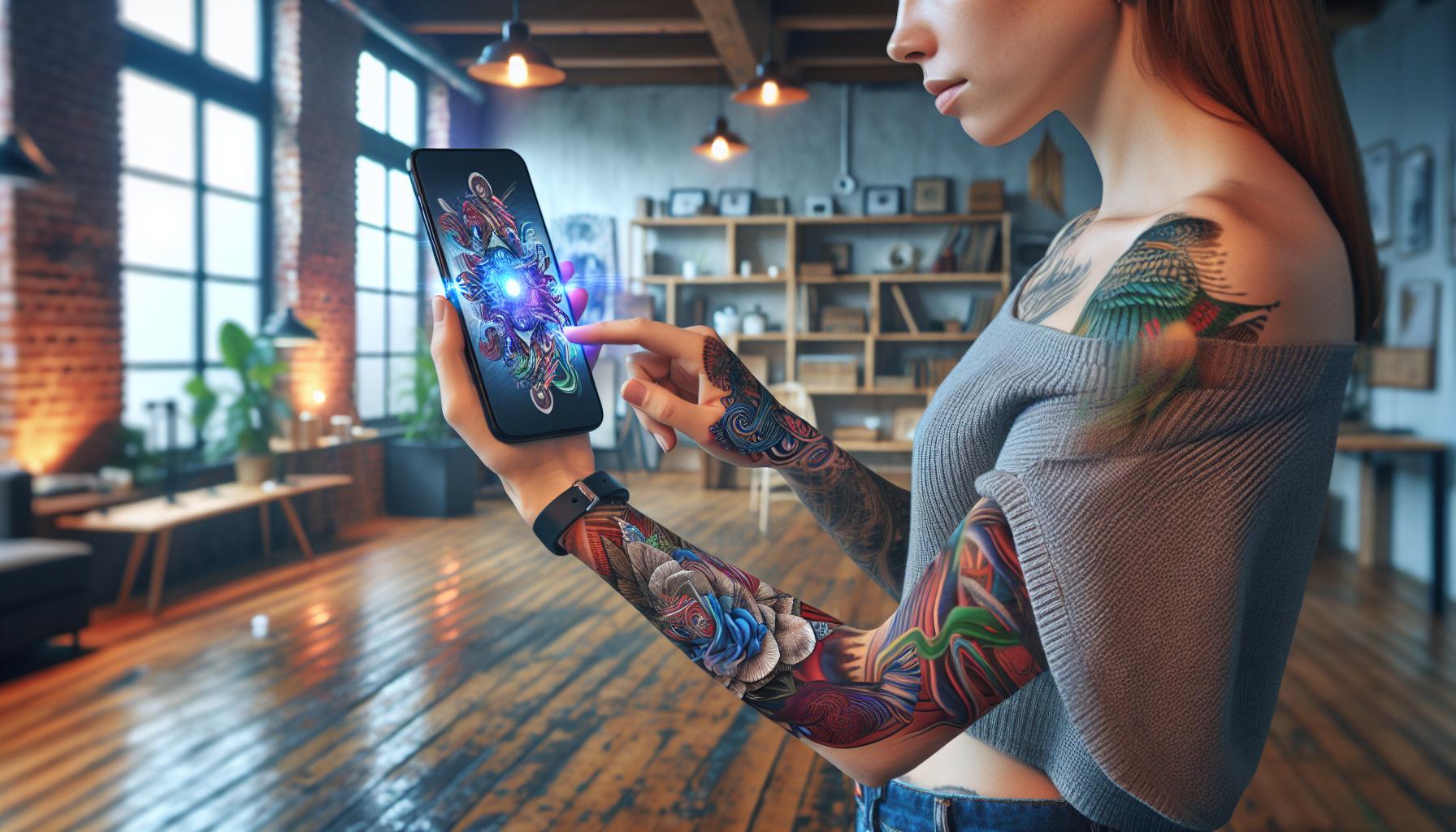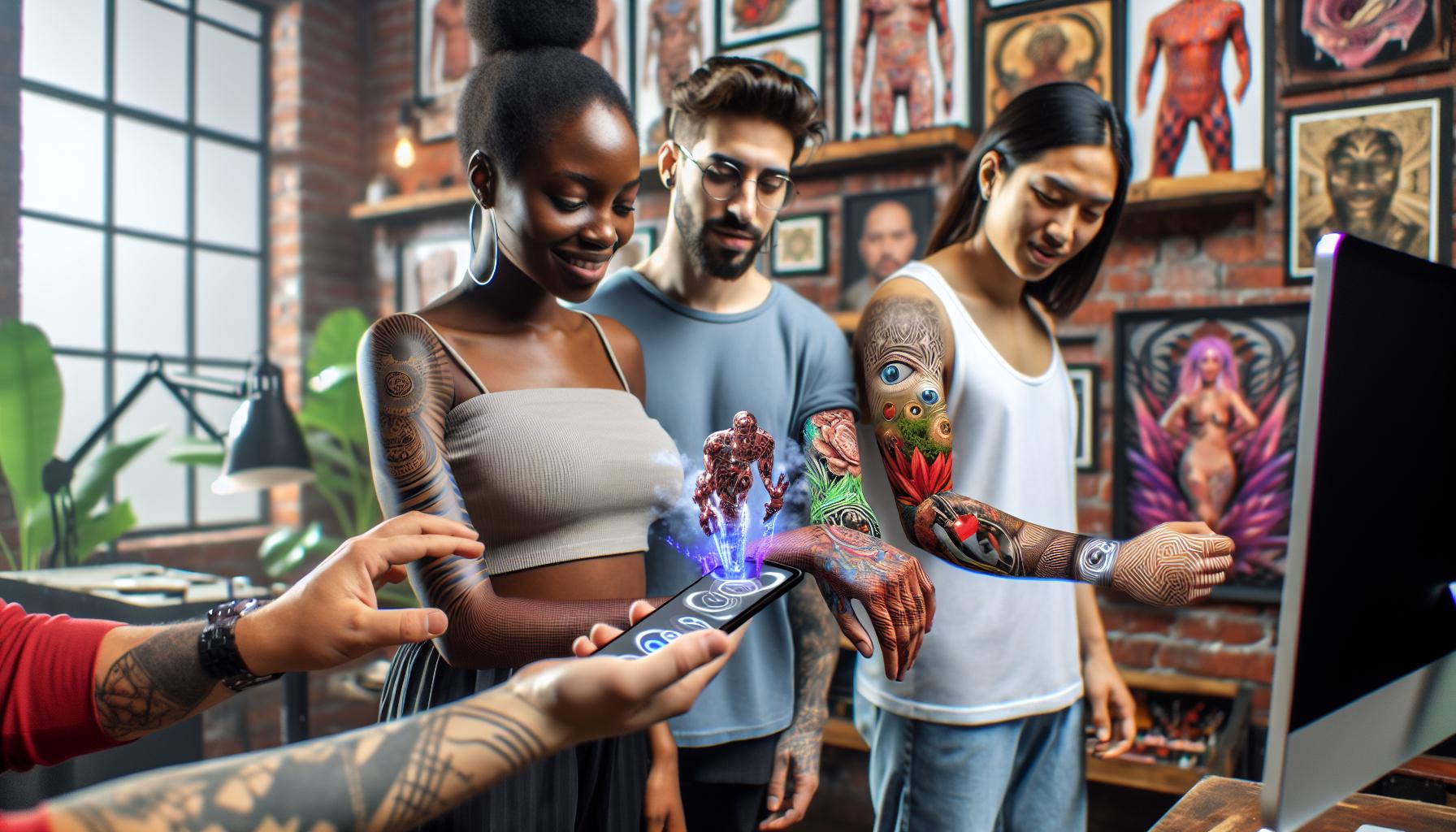Imagine walking into a tattoo parlor and leaving with a design that’s not only inked on your skin but also comes to life with a simple scan. Augmented reality tattoos are shaking up the tattoo game, blending art and technology in a way that’s both mind-boggling and downright cool. These aren’t your grandma’s tattoos; they’re a fusion of creativity and innovation that can transform a static design into an interactive experience.
With augmented reality tattoos, the possibilities are endless. Want your dragon to breathe fire or your floral design to sway in the breeze? Just point your device and watch the magic unfold. It’s like having a personal hologram that’s always ready to impress. Dive into this exciting world where body art meets cutting-edge tech, and discover how augmented reality is redefining self-expression—one tattoo at a time.
Augmented Reality Tattoos
Augmented reality tattoos represent a groundbreaking fusion of body art and digital technology. This innovation allows individuals to experience tattoos beyond their static appearance. Users can witness their designs animate or transform using a smartphone or tablet. The experience is achieved through a simple scanning process that activates augmented reality features.
Different platforms and applications enhance the functionality of augmented reality tattoos. Artists and designers can create intricate animations, making each tattoo a unique interactive experience. This technology opens a fresh avenue for personal expression, as wearers express individuality in dynamic ways.
Several industries benefit from augmented reality tattoos. The fashion sector leverages these innovative designs for promotional campaigns, while gaming industries incorporate them into storytelling. Education also finds utility, using tattoos to engage learners through interactive lessons about art or culture.
Technological advancements contribute to the growth of augmented reality tattoos. Software developers continuously refine AR applications to enhance user experience. Furthermore, the tattoo community embraces this trend, as artists explore new creative possibilities, blending traditional techniques with cutting-edge technology.
Growing popularity drives interest in augmented reality tattoos. Many people appreciate how this innovation can redefine personal expression. As awareness spreads, enthusiasts eagerly anticipate future developments in this captivating intersection of art and technology.
How Augmented Reality Tattoos Work

Augmented reality tattoos leverage advanced technology to create interactive experiences with body art. These tattoos engage users by transforming static designs into dynamic visuals.
The Technology Behind AR Tattoos
AR tattoos utilize a combination of digital imaging and mobile applications. 3D mapping software interprets the tattoo’s design, enabling it to overlay digital animations. Artists use graphic design tools to create unique visuals that respond to user interactions. Scanning the tattoo with a compatible device activates the augmented content, enhancing the visual appeal. Quality projection depends on the accuracy of both the tattoo’s design and the technology used for viewing. Continuous developments in AR technology improve the overall experience, making it more accessible to tattoo enthusiasts.
User Interaction and Experience
User experience is central to AR tattoos, as interaction plays a key role in their appeal. Users engage with animations through movements, tapping, or rotating their devices. Each interaction offers a new layer of immersion, allowing for personalized experiences. The technology encourages sharing on social media platforms, amplifying audience reach. Users appreciate how AR tattoos can evolve over time, with updates adding new features or designs. The blend of physical and digital enhances self-expression, making every tattoo a unique canvas for creativity.
Benefits Of Augmented Reality Tattoos

Augmented reality tattoos offer a range of benefits that enhance the tattoo experience. These tattoos integrate art and technology, providing users with unique advantages.
Improved Design Visualization
Enhanced visualization plays a crucial role in the appeal of augmented reality tattoos. Users can preview their tattoo designs in a dynamic format before committing to permanent ink. Visualizing designs in real-time helps in assessing scale, detail, and placement. This technology reduces the uncertainty associated with traditional tattoos, making the decision process clearer and less daunting. Additionally, artists can modify designs interactively based on user feedback, ensuring client satisfaction is at the forefront of the creative process.
Enhanced User Engagement
User engagement significantly improves with augmented reality tattoos. Interactivity transforms static designs into experiences that captivate audiences. Viewers can interact with their tattoos through motion, enabling animations to change as the user moves. This living art form prompts sharing on social media, allowing users to showcase their unique tattoos to a broader community. Engaging with others who share similar interests fosters a sense of belonging and excitement within the tattoo culture. Additionally, the novelty of augmented reality fosters curiosity, drawing in new users eager to explore the blend of artistry and technology.
Challenges And Limitations

Augmented reality tattoos face several notable challenges. These obstacles can impact their widespread adoption and overall effectiveness in this innovative art form.
Technical Limitations
Technical constraints hinder the functionality of augmented reality tattoos. Limited battery life on mobile devices restricts extended viewing periods for animations. Variability in camera quality across devices impacts the clarity of AR displays, leading to inconsistencies in user experiences. Moreover, software compatibility issues may arise, with certain applications struggling to run smoothly on various platforms. In addition, intricate designs might present challenges for 3D mapping software, as these systems depend on high-quality imaging for accurate overlays. Such factors can detract from the immersive potential these tattoos aim to deliver.
User Acceptance and Adoption
User acceptance significantly influences the growth of augmented reality tattoos. Some individuals may exhibit skepticism regarding the permanence of traditional tattoos alongside digital experiences. A portion of the tattoo community values traditional artistry and may resist embracing technology in this context. Social acceptance also plays a role, as concerns over digital privacy and data security may dissuade potential users. Furthermore, a lack of awareness about how augmented reality tattoos work can limit interest. Building trust and familiarity within both the tattoo culture and the general public remains essential for broader adoption of this merging of art and technology.

